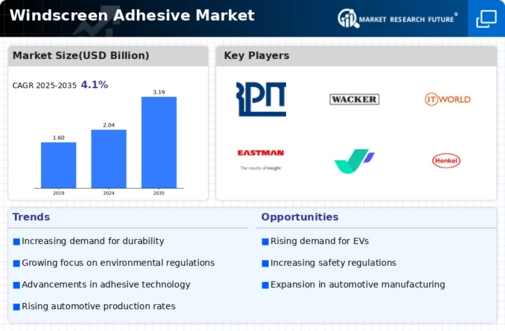Increasing Automotive Production
The rising automotive production is a pivotal driver for the Windscreen Adhesive Market. As manufacturers ramp up vehicle output to meet consumer demand, the need for reliable and efficient adhesives becomes paramount. In recent years, the automotive sector has witnessed a steady growth rate, with production figures reaching approximately 90 million vehicles annually. This surge necessitates the use of high-performance windscreen adhesives that ensure safety and durability. Furthermore, the trend towards lightweight vehicles has prompted manufacturers to seek adhesives that not only bond effectively but also contribute to overall vehicle efficiency. Consequently, the increasing automotive production is likely to bolster the demand for windscreen adhesives, thereby propelling the market forward.
Growth of the Aftermarket Repair Sector
The growth of the aftermarket repair sector is a notable driver for the Windscreen Adhesive Market. As vehicles age, the need for repairs and replacements, particularly for windscreens, becomes more prevalent. The aftermarket segment is projected to expand significantly, with estimates suggesting a growth rate of around 10% annually. This expansion is driven by an increasing number of vehicles on the road and a rising preference for cost-effective repair solutions. Consequently, the demand for high-quality windscreen adhesives in the aftermarket sector is likely to increase, as repair shops seek reliable products that ensure safety and durability. This trend presents a substantial opportunity for manufacturers within the windscreen adhesive market.
Regulatory Compliance and Safety Standards
Regulatory compliance and safety standards are crucial drivers for the Windscreen Adhesive Market. Governments and regulatory bodies worldwide are increasingly enforcing stringent safety regulations for automotive components, including windscreen installations. These regulations mandate the use of high-quality adhesives that can withstand various stressors, ensuring passenger safety. For example, the implementation of crash safety standards has necessitated the use of adhesives that provide robust bonding under impact conditions. Market analysis suggests that adherence to these regulations is expected to increase the demand for certified windscreen adhesives, as manufacturers seek to comply with safety standards. Consequently, the emphasis on regulatory compliance is likely to propel the growth of the windscreen adhesive market.
Rising Consumer Awareness of Vehicle Safety
Rising consumer awareness of vehicle safety is a significant driver for the Windscreen Adhesive Market. As consumers become more informed about the importance of safety features in vehicles, the demand for high-quality windscreen adhesives is expected to increase. This awareness is partly fueled by media coverage of automotive safety ratings and the impact of windscreen integrity on overall vehicle safety. Market Research Future indicates that consumers are willing to invest in vehicles equipped with advanced safety features, including superior windscreen bonding solutions. This trend is likely to encourage manufacturers to prioritize the use of high-performance adhesives in their production processes, thereby driving growth in the windscreen adhesive market.
Technological Advancements in Adhesive Formulations
Technological advancements in adhesive formulations are significantly influencing the Windscreen Adhesive Market. Innovations in chemistry and material science have led to the development of advanced adhesives that offer superior bonding capabilities and faster curing times. For instance, the introduction of polyurethane and silicone-based adhesives has enhanced the performance characteristics of windscreen adhesives, making them more resilient to environmental factors. Market data indicates that the adoption of these advanced formulations is expected to grow by over 15% in the coming years. This trend not only improves the safety and longevity of windscreen installations but also aligns with the automotive industry's push for enhanced performance standards. As a result, the continuous evolution of adhesive technologies is likely to drive growth in the windscreen adhesive sector.

















Leave a Comment